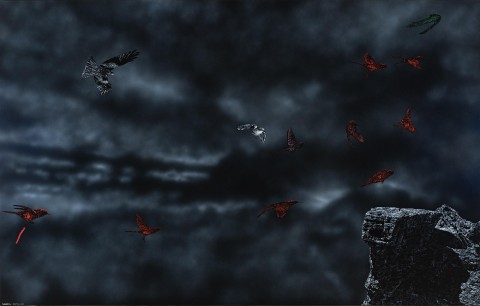LOOKOUT #1, 2007
SHANE COTTON
synthetic polymer paint on canvas
200.0 x 300.0 cm
signed, dated and inscribed with title lower left: LOOKOUT 1 S. COTTON. 2007
signed, dated and inscribed with title verso: “LOOKOUT 1” / Shane L Cotton / 2007
Sherman Galleries, Sydney (stamped verso)
Gene and Brian Sherman Collection, Sydney
Shane Cotton, Red Shift, Sherman Galleries, Sydney, 28 June – 14 July 2007, cat. 6
Shane Cotton, The Hanging Sky, Christchurch Art Gallery Te Puna O Waiwhetu, Christchurch, New Zealand, 15 June – 6 October 2012; Institute of Modern Art, Brisbane, 8 December 2012 – 2 March 2013; Campbelltown Arts Centre, Sydney, 23 March – 19 May 2013
Paton, J., (et al.) Shane Cotton: The Hanging Sky, Christchurch Art Gallery, Christchurch, New Zealand, 2013, pp. 24 – 25 (illus.)
Paton, J., ‘In the Air: Shane Cotton’s Recent Paintings’, Shane Cotton To and Fro, exhibition catalogue, Rossi and Rossi, London, 2010, p. 11
Red Shift, 2006 – 07, synthetic polymer paint on canvas, 190.0 x 300.0 cm, in the collection of the Queensland Art Gallery, Brisbane
Takarangi, 2007, synthetic polymer paint on linen, 190.0 x 300.0 cm, in the collection of the Christchurch Art Gallery Te Puna o Waiwhetu, Christchurch
‘Stepping up to the painting, I found myself on the edge of a blue-black void, a space whose colours suggested some time before or beyond day or night’.
Shane Cotton is undoubtedly one of New Zealand’s leading contemporary artists, drawing on a wealth of art historical references, from Colin McCahon to René Magritte. Strongly informed by and actively informing contemporary post-colonial discourse, Cotton mines his own mixed cultural heritage (both Māori and Pākehā) to create an artistic language that resonates with audiences around the world. Lookout #1, 2007 is a key work from Cotton’s acclaimed series of vertiginous skyscapes. Spectators are plunged into an otherworldly void inhabited solely by feathered emissaries, birds who remain curiously suspended in a liminal space where gravity holds no purchase. Infused with the gothic tension of a brooding storm, whose origins and effects remain unknown, Lookout #1 displays a dichotomy between the promontory referred to in its title and carefully rendered in the lower right-hand corner, and the disorienting obscurity that dominates the rest of the painting’s vast plane. The void presents a metaphor of suspense and potential – an unknown point of departure for both artist and viewer.
Cotton is propelled by a desire to streamline and synthesise his visual syntax and works from this series are remarkably minimal. Depicting a disorienting and illogical moment between day and night and a view with no clear vanishing point, they mark a progression from his early landscape paintings. Formerly defined by their clear horizon lines, Cotton’s landscapes now were redirected to vast celestial vaults, illuminated by neither the moon nor the sun. Looking away from the carved-up and disputed land underfoot also gave Cotton an opportunity to move away from the prevailing culture politics in New Zealand, which overdetermined readings of his landscape works. The unconquered skies provided a more inclusive space, uncertain and syncretic. In Māori cosmology, the Hanging Sky describes a sky draped down to meet the edge of the earth through which spiritual voyagers can pass.1
With wings outstretched and flattened into improbable shapes, Cotton’s brightly coloured birds appear to be buffeted by gale force winds, thrown perilously close to the cliff face. The artist himself describes the scene as ‘the birds were stopped and it was the mountains that were moving, or, in terms of the way the marks were flowing, had the potential to move’.2 Often carrying symbolic or devotional meaning in paintings, the birds in Cotton’s syncretic metaphysical space remain ambiguous. The sense of the uncanny is heightened by the discordance between a naturalistic painted cliff, magnified in the foreground, and the birds rendered in light graphic lines, delicately applied to the painted surface like a decal. This post-modernist free-association and appropriation of images, symbols and text would proliferate in Cotton’s later works, bizarre flights of fancy suspended in space, untethered to any point of reference. Art historians identify this tendency as a surrealist technique, indeed Robert Leonard qualifies Cotton’s approach as ‘speculative cultural surrealist’.3
Exhibited alongside its related works in the acclaimed retrospective exhibition, The Hanging Sky, at Christchurch Art Gallery, Lookout #1 is an imposing and major work of Cotton’s oeuvre, lyrically exploring the physical and metaphysical limits of a culturally specific narrative.
1. Paton, J., (et al.), Shane Cotton: The Hanging Sky, Christchurch Art Gallery, Christchurch, 2013, p. 42
2. Paton, J., ‘Shane Cotton. Stamina, Surprise and Suspense’, Bulletin Magazine, Christchurch Art Gallery, Christchurch, Issue 170, December 2012
3. Leonard, R., ‘The Treachery of Images’, in Paton, J., (et al.), op cit., p. 136
LUCIE REEVES-SMITH
